概述
目录
1.踩过的坑(tensorflow)
2.tensorboard
3.代码实现(python3.5)
4.运行结果以及分析
1.踩过的坑(tensorflow)
上一章CNN中各个算法都是纯手工实现的,可能存在一些难以发现的问题,这也是准确率不高的一个原因,这章主要利用tensorflow框架来实现卷积神经网络,数据源还是cifar(具体下载见上一章)
在利用tensorflow框架实现CNN时,需要注意以下几点:
1.输入数据定义时,x只是起到占位符的作用(看不到真实值,只是为了能够运行代码,获取相应的tensor节点,这一点跟我们之前代码流程完全相反, 真正数据流的执行在session会话里)
x:输入数据,y_: 标签数据,keep_prob: 概率因子,防止过拟合。
定义,且是全局变量。
x = tf.placeholder(tf.float32, [None, 3072], name='x')
y_ = tf.placeholder(tf.float32, [None, 10], name='y_')
keep_prob = tf.placeholder(tf.float32)
后面在session里必须要初始化
sess.run(tf.global_variables_initializer())
在session run时必须要传得到该tensor节点含有参数值(x, y_, keep_prob)
train_accuracy = accuracy.eval(feed_dict={
x: batch[0], y_: batch[1], keep_prob: 1.0})
2.原始数据集标签要向量化;
例如cifar有10个类别,如果类别标签是 6 对应向量[0,0,0,0,0,1,0,0,0,0]
3.知道每一步操作的数据大小的变化,不然,报错的时候很难定位(个人认为这也是tensorflow的弊端,无法实时追踪定位);
注意padding = 'SAME'和'VALID'的区别
padding = 'SAME' => Height_后 = Height_前/Strides 跟padding无关 向上取整
padding = 'VALID'=> Height_后 = (Height_前 - Filter + 1)/Strides 向上取整
4.打印tensorboard流程图,可以直观看到每步操作数据大小的变化;
2. tensorboard
tensorboard就是一个数据结构流程图的可视化工具,通过tensorboard流程图,可以直观看到神经网络的每一步操作以及数据流的变化。
操作步骤:
1. 在session会话里加入如下代码,打印结果会在当前代码文件相同路径的tensorboard文件下,默认是
tf.summary.FileWriter("tensorboard/", sess.graph)
2. 在运行里输入cmd,然后输入(前提是安装好了tensorboard => pip install tensorboard)
tensorboard --logdir=D:ProjectpythonmyProjectCNNtensorflowcaptchaIdentifytensorboard --host=127.0.0.1
'D:ProjectpythonmyProjectCNNtensorflowcaptchaIdentifytensorboard' 是我生成的tensorboard文件的绝对路径,你替换成你自己的就可以了。
正确运行后会显示 ‘Tensorboard at http://127.0.0.1:6006’,说明tensorboard服务已经起来了,在浏览器页面输入
http://127.0.0.1:6006即可显示流程图。
3.代码实现(python3.6)
代码逻辑实现相对比较简单,在一些重要逻辑实现上,我已做了注释,如果大家有什么疑义,可以留言给我,我们一起交流。
因为原始图片数据集太大,不好上传,大家可以直接在http://www.cs.toronto.edu/~kriz/cifar.html下载CIFAR-10 python version,
有163M,放在代码文件同路径下即可。
cifar放置路径
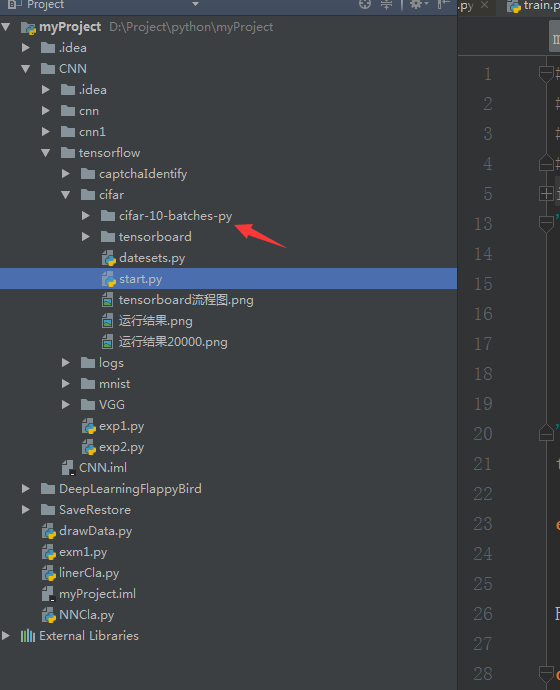
start.py
 View Code
View Code
datasets.py

1 import numpy
2 from tensorflow.python.framework import dtypes
3 from tensorflow.python.framework import random_seed
4 from six.moves import xrange
5 from tensorflow.contrib.learn.python.learn.datasets import base
6 import pickle
7 import os
8
9 class DataSet(object):
10 """Container class for a dataset (deprecated).
11
12 THIS CLASS IS DEPRECATED. See
13 [contrib/learn/README.md](https://www.tensorflow.org/code/tensorflow/contrib/learn/README.md)
14 for general migration instructions.
15 """
16 def __init__(self,
17 images,
18 labels,
19 fake_data=False,
20 one_hot=False,
21 dtype=dtypes.float32,
22 reshape=True,
23 seed=None):
24 """Construct a DataSet.
25 one_hot arg is used only if fake_data is true. `dtype` can be either
26 `uint8` to leave the input as `[0, 255]`, or `float32` to rescale into
27 `[0, 1]`. Seed arg provides for convenient deterministic testing.
28 """
29 seed1, seed2 = random_seed.get_seed(seed)
30 # If op level seed is not set, use whatever graph level seed is returned
31 numpy.random.seed(seed1 if seed is None else seed2)
32 dtype = dtypes.as_dtype(dtype).base_dtype
33 if dtype not in (dtypes.uint8, dtypes.float32):
34 raise TypeError(
35 'Invalid image dtype %r, expected uint8 or float32' % dtype)
36 if fake_data:
37 self._num_examples = 10000
38 self.one_hot = one_hot
39 else:
40 assert images.shape[0] == labels.shape[0], (
41 'images.shape: %s labels.shape: %s' % (images.shape, labels.shape))
42 self._num_examples = images.shape[0]
43
44 # Convert shape from [num examples, rows, columns, depth]
45 # to [num examples, rows*columns] (assuming depth == 1)
46 if reshape:
47 assert images.shape[3] == 3
48 images = images.reshape(images.shape[0],
49 images.shape[1] * images.shape[2] * images.shape[3])
50 if dtype == dtypes.float32:
51 # Convert from [0, 255] -> [0.0, 1.0].
52 images = images.astype(numpy.float32)
53 images = numpy.multiply(images, 1.0 / 255.0)
54 self._images = images
55 self._labels = labels
56 self._epochs_completed = 0
57 self._index_in_epoch = 0
58
59 @property
60 def images(self):
61 return self._images
62
63 @property
64 def labels(self):
65 return self._labels
66
67 @property
68 def num_examples(self):
69 return self._num_examples
70
71 @property
72 def epochs_completed(self):
73 return self._epochs_completed
74
75 def next_batch(self, batch_size, fake_data=False, shuffle=True):
76 """Return the next `batch_size` examples from this data set."""
77 if fake_data:
78 fake_image = [1] * 784
79 if self.one_hot:
80 fake_label = [1] + [0] * 9
81 else:
82 fake_label = 0
83 return [fake_image for _ in xrange(batch_size)], [
84 fake_label for _ in xrange(batch_size)
85 ]
86 start = self._index_in_epoch
87 # Shuffle for the first epoch
88 if self._epochs_completed == 0 and start == 0 and shuffle:
89 perm0 = numpy.arange(self._num_examples)
90 numpy.random.shuffle(perm0)
91 self._images = self.images[perm0]
92 self._labels = self.labels[perm0]
93 # Go to the next epoch
94 if start + batch_size > self._num_examples:
95 # Finished epoch
96 self._epochs_completed += 1
97 # Get the rest examples in this epoch
98 rest_num_examples = self._num_examples - start
99 images_rest_part = self._images[start:self._num_examples]
100 labels_rest_part = self._labels[start:self._num_examples]
101 # Shuffle the data
102 if shuffle:
103 perm = numpy.arange(self._num_examples)
104 numpy.random.shuffle(perm)
105 self._images = self.images[perm]
106 self._labels = self.labels[perm]
107 # Start next epoch
108 start = 0
109 self._index_in_epoch = batch_size - rest_num_examples
110 end = self._index_in_epoch
111 images_new_part = self._images[start:end]
112 labels_new_part = self._labels[start:end]
113 return numpy.concatenate(
114 (images_rest_part, images_new_part), axis=0), numpy.concatenate(
115 (labels_rest_part, labels_new_part), axis=0)
116 else:
117 self._index_in_epoch += batch_size
118 end = self._index_in_epoch
119 return self._images[start:end], self._labels[start:end]
120
121 def read_data_sets(train_dir,
122 one_hot=False,
123 dtype=dtypes.float32,
124 reshape=True,
125 validation_size=5000,
126 seed=None):
127
128
129
130
131 train_images,train_labels,test_images,test_labels = load_CIFAR10(train_dir)
132 if not 0 <= validation_size <= len(train_images):
133 raise ValueError('Validation size should be between 0 and {}. Received: {}.'
134 .format(len(train_images), validation_size))
135
136 validation_images = train_images[:validation_size]
137 validation_labels = train_labels[:validation_size]
138 validation_labels = dense_to_one_hot(validation_labels, 10)
139 train_images = train_images[validation_size:]
140 train_labels = train_labels[validation_size:]
141 train_labels = dense_to_one_hot(train_labels, 10)
142
143 test_labels = dense_to_one_hot(test_labels, 10)
144
145 options = dict(dtype=dtype, reshape=reshape, seed=seed)
146 train = DataSet(train_images, train_labels, **options)
147 validation = DataSet(validation_images, validation_labels, **options)
148 test = DataSet(test_images, test_labels, **options)
149
150 return base.Datasets(train=train, validation=validation, test=test)
151
152
153 def load_CIFAR_batch(filename):
154 """ load single batch of cifar """
155 with open(filename, 'rb') as f:
156 datadict = pickle.load(f, encoding='bytes')
157 X = datadict[b'data']
158 Y = datadict[b'labels']
159 X = X.reshape(10000, 3, 32, 32).transpose(0,2,3,1).astype("float")
160 Y = numpy.array(Y)
161 return X, Y
162
163 def load_CIFAR10(ROOT):
164 """ load all of cifar """
165 xs = []
166 ys = []
167 for b in range(1,6):
168 f = os.path.join(ROOT, 'data_batch_%d' % (b, ))
169 X, Y = load_CIFAR_batch(f)
170 xs.append(X)
171 ys.append(Y)
172 Xtr = numpy.concatenate(xs)
173 Ytr = numpy.concatenate(ys)
174 del X, Y
175 Xte, Yte = load_CIFAR_batch(os.path.join(ROOT, 'test_batch'))
176 return Xtr, Ytr, Xte, Yte
177
178 def dense_to_one_hot(labels_dense, num_classes):
179 """Convert class labels from scalars to one-hot vectors."""
180 num_labels = labels_dense.shape[0]
181 index_offset = numpy.arange(num_labels) * num_classes
182 labels_one_hot = numpy.zeros((num_labels, num_classes))
183 labels_one_hot.flat[index_offset + labels_dense.ravel()] = 1
184 return labels_one_hot
4.运行结果以及分析
这里选取55000张图片作为训练样本,测试样本选取5000张。
tensorboard可视流程图
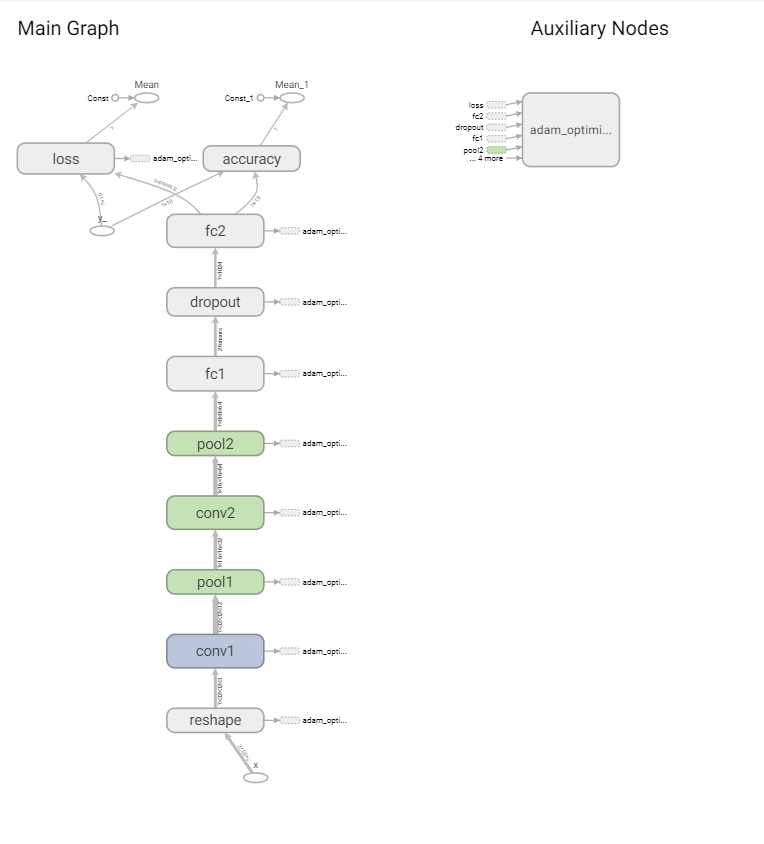
运行5000次,测试准确率:58%
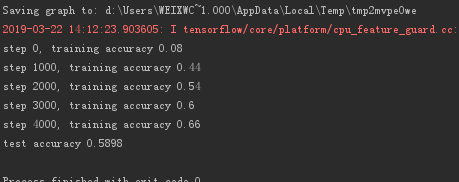
运行20000次,测试准确率:68.89%
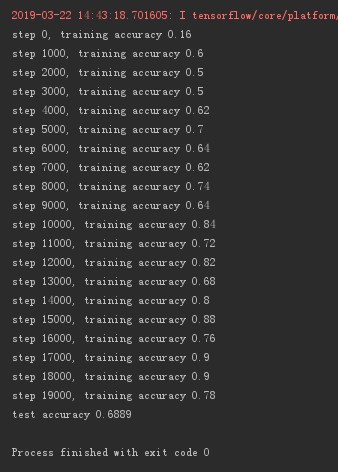
运行40000次,测试准确率71.95%
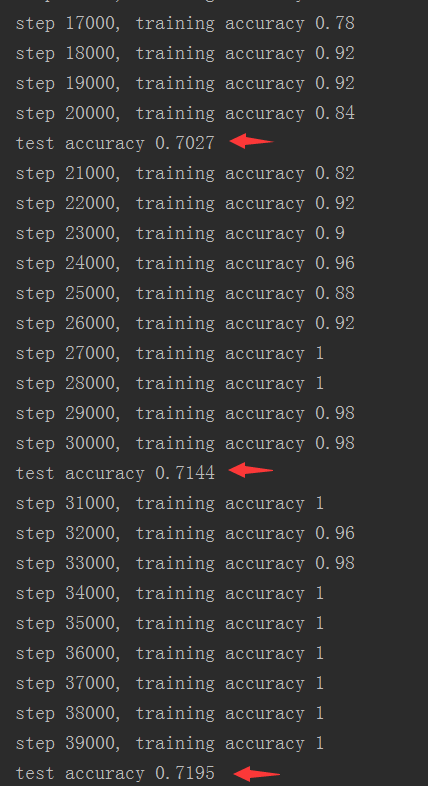
分析:由最后一张图片可以看出,20000 - 30000次时测试准确率=> 70.27% ->71.44%,30000 - 40000次时=> 71.44% -> 71.95%
而训练准确率已经达到100%,说明测试准确率已经趋于一个稳定值,再增加训练次数,测试准确率提高的可能性不大。
如果想要继续提高测试准确率,就只能增加训练样本。
最后
以上就是靓丽柜子为你收集整理的用Tensorflow实现卷积神经网络(CNN)的全部内容,希望文章能够帮你解决用Tensorflow实现卷积神经网络(CNN)所遇到的程序开发问题。
如果觉得靠谱客网站的内容还不错,欢迎将靠谱客网站推荐给程序员好友。






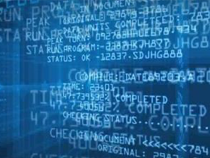

发表评论 取消回复